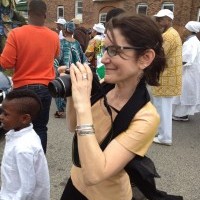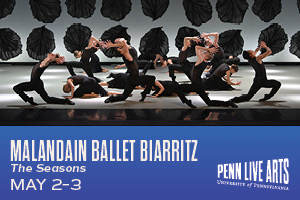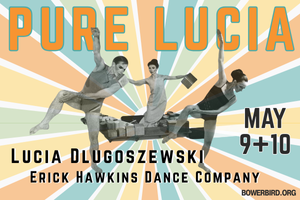
Didik in Philadelphia
by Toni Shapiro-Phim
“Always remain humble in front of your teacher, acting as if you know nothing, so you are ready to take in what the teacher has to give.”
-- Kwee Liang Ek, Didik’s grandfather
March 6: Balinese and Javanese Dance at Swarthmore
Didik Nini Thowok glides across the stage of Swarthmore College’s Lang Concert Hall, knees slightly bent, evoking at once a firm connection to the ground and an ethereal lightness. Manipulating a red and gold fan in his right hand, every now and then he lifts one side of the selendang (sash tied around his waist) with his left, flicking the end up and away. Didik spent a week in residence in Philadelphia at the invitation of Intercultural Journeys as part of their Borders and Boundaries season. He began his visit with this workshop, which he opened with a demonstration of a ritual Balinese dance.
Didik is from the island of Java, just to the west of Bali among Indonesia's 14,000+ islands. His workshop at Swarthmore included discussion and presentation of some differences between Balinese and Javanese movement aesthetics. Being skilled in both, Didik brought members of the audience onto the stage with him where he molded their hands into classical Javanese dance gestures, noting that while the fingers in Balinese dance might fan out slightly as they quiver with energy, in Javanese classical tradition, they never do so, moving instead with fluid, serene grace.
Balinese dance is often a form of worship, performed in Hindu temple compounds. Balinese dancers focus straight ahead, their gaze landing upon the foreheads or even just above the heads of those who have come to watch. Javanese dance, on the other hand, was developed in royal courts, Didik explained; therefore a dancer’s eyes must not look directly ahead to the audience (nor to the sultan). Instead, they are focused downward, to the front, at a slight angle. Even within Javanese classical tradition, there are distinct styles rooted in separate courts on the same island, those of Surakarta (also known as Solo) and Yogyakarta. The basic stance in Solo style includes a gentle bend of the torso forward, from the hips up, for example. Yogyakarta style employs a straighter bearing.
Didik began his dance training at age 12, in Solo style. He learned just as he taught workshop participants at Swarthmore, with the physical touch of teacher to student ensuring proper body placement, and transferring energy from accomplished practitioner to novice.
Artistic Development
“It is better to be the ruler of a small kingdom than to be a soldier in a large realm."
-- The late I Gusti Agung Ngurah Supartha, Didik's Balinese dance teacher
"Pray in the way that is right for you, following your own tradition."
-- The late Mimi Sudji, Didik's masked dance of Cirebon teacher
“When I was little, my teacher told me I should dance women’s roles," Didik shares, “because I was luwes (supple), and because I was good at it.” Cross-gender dancing had existed for centuries in Indonesia. When Didik was young, his grandparents would often take him to see performances of traveling Wayang Wong (dance drama) and Ludruk (East Javanese folk drama) troupes, both of which included men performing as women and/or women performing as men. Didik was so entranced that back at home, he’d imitate the artists’ movements and try to re-create their make-up on his own face. In the mid-twentieth century, Indonesia’s government proclaimed that cross-gender performance was no longer permitted in Javanese classical dance. By the time he was in high school, just because he performed the women’s roles in that dance form, Didik was being teased by fellow students who called him banci, which translates as an effeminate man who dresses as a woman and is assumed to prostitute himself.
He persevered, enrolling at the Akademi Seni Tari Indonesia (ASTI, National Academy of Indonesian Dance), after a year of teaching dance in his hometown. At ASTI, he was introduced to Javanese dance of the Yogyakarta style, as well as Balinese and other forms of Indonesian dance. (Indonesia has an enormous diversity of movement traditions from its hundreds of ethnic groups.) But without classes for cross-gender performers – “I didn’t see classes for dancers like me, and didn’t see men dancing as women in classical genres” – he decided to focus on prioritizing his pedagogical technique. “I had to think, ‘What am I going to do?’ I want to be a dancer, but nobody is like me. I felt alone. And I had to be realistic. So I focused on becoming the best possible teacher of female roles that I could.” It was only when he added comedic elements to his performances that he became more widely accepted as a cross-gender dancer. Indeed, after he was tapped to star in a new piece choreographed by Bekti Budi Hastuty, called Nini Thowok, he became so well-known as a comedic dancer, with performances on television, and at weddings and building inaugurations, that he took on the stage name, Didik Nini Thowok.
Also while at the Academy, Didik began his studies of masked dance traditions of Bali, Java and other regions of Indonesia. Didik shares that he has been discriminated against in Indonesia for being of Chinese heritage (his father is Chinese; his mother is Javanese), for being Christian in a predominantly Muslim nation, and for performing as a woman, which some take to mean that he’s transsexual. Both masks and comedy hold the potential to shift identities and disrupt assumptions.[1]
Endo Suanda, a teacher at ASTI, introduced Didik to Mimi Sudji of Cirebon, in West Java, who instructed Didik in the intricacies of the masked dance of her region. It was through this relationship that Didik developed his deep attachment to masks and the possibilities they offer for both the hiding and revealing of identities.
At the conclusion of intensive study, Mimi Sudji insisted that Didik undergo a ritual to bless him and prepare him for performances of masked dance of Cirebon. The rite was rooted in Javanese practices of Islam. “Privately, in her room, my teacher prayed. She prepared a bucket of water with special flowers in it. I was told to bathe – to pour that bucket of water over me – outside, under the full moon.” But before bathing with the sacred water, Didik was asked to pray as one would if one were Muslim. “I told her I am Christian and I couldn’t say those prayers,” Didik recounts. “She said, ‘No problem.’ I should first pray the way I need to, then hold my breath and pour the water over my head and body seven times. Later, I was told I was lucky to have gotten such a blessing from my teacher. Not everyone gets that.” If the teacher loves a student, Didik explains, the student will receive such a consecration.
“Every time I dance masked dance of Cirebon, I see my teacher dancing in front of me. I just feel my teacher moving." One time a dancer from Cirebon who was observing Didik as he taught another student broke out in tears. She was crying because as she watched him, she saw Mimi Sudji in his place.
For any of the masked dances Didik performs, he says he must first “understand the character. Then, when I put the mask on my face, I will suddenly transform into that character. And I will move like the character.” In addition to executing the technique, a dancer must find and convey the soul of a particular expressive tradition. This ability, he maintains, arises only when one not only spends time in the community that has nurtured that tradition, but also when one checks assumptions and ego at the door, and makes oneself open and vulnerable. This approach has afforded him the opportunity to become accomplished in a number of styles and genres of dance, many from across Indonesia, and others from abroad, including Japan and India.
March 10: Lengger Banyumas master class at Headlong Dance Studio
Thirty women and girls (and one man) of Indonesian heritage – plus one man who showed up by accident, thinking this was the day of Didik’s performance – filled the dance studio, hanging on Didik’s every movement and word. Here was a famous star from their homeland (or their parents’ homeland), offering them a lesson in a form of dance which none had performed before. (One participant said it was like seeing a favorite TV character come to life.) This group of girls and women were, for the most part, members of Modero Traditional and Fusion Indonesian Dance Company. Founded by Sinta Penyami Storms in 2011, Modero is a central feature of Philadelphia’s Indonesian community events. A 70-year-old grandmother and her 13-year old granddaughter, both Modero members, were among Didik’s students. Sinta requested and made arrangements for this workshop so that Modero dancers could “learn directly from and be molded into position by a master artist.” She also wanted them to see, in person, an Indonesian dance performance of such high caliber.
A bit flirtatious and suggestive, Lengger is popular with people of all socioeconomic classes, though religious fundamentalists have spoken out against it, noting its overt sensuality. Didik continues the historic cross-gender representation in Lengger in this piece , Lengger Banyumas, which he choreographed. He demonstrated a basic hand gesture, along with ways to manipulate the long scarf hanging from his neck, and the syncopated bounces of the torso, for performance as a female. Elements of the posture were difficult for the dancers: Didik moved from student-to-student, gently pushing the small of the back to encourage an arch, touching the leg or foot to emphasize a turn-out or lifting the arms so they were held at shoulder height. On Facebook, participants shared how sore they were the next day. And how grateful.
March 11: Three dances at International House
As the lights dimmed in the theater, the audience focused on a dressing table, complete with mirror and chair, set to the left side of the stage. A lone xylophone was all the way to the right, with musician Sean Hayward seated behind it. Didik made his way onto the stage, singing a plaintive song to both rid the immediate surroundings of evil spirits and provide protection. Then, seated at the table, and still engaged in song, he proceeded to complete his adornment, placing golden combs in his traditional wig. Next, he rose, entering into a performance of Gambyong Pangkur, a Javanese dance from Surakarta representing a woman as she dresses up, gently folding her wrists in and out, manipulating the ends of the long scarf tied around her waist.
His second offering, following an instrumental interlude by Sean on synthesizer, guitar and gender (Balinese xylophone), was Lengger Banyumas, which he had taught members of Modero Dance Company the day before. And his final piece was one for which he's particularly well-known, Dwimuka Jali, in which all the characters he portrays, again, are female.
Beginning by facing the audience, masked, arms raised to the sides, Didik performed in Javanese style, only later revealing, by turning around, that he had had his back to us the entire time. The mask had been on the back of his head. The real front of him was in Balinese costume and once he showed the audience that side, he transitioned into a Balinese dance. But that wasn’t the end. Didik proceeded to change costume, headdress and mask, again and again, right in front of us, ending in a comic dance, playing with stereotypes of age and gender with unanticipated boogying and a flirtatious go at partner dancing with a man he plucked from the audience.
Ratri Anindyajati, creative producer and Didik's international manager, graduate of the California Institute of the Arts and also a native of Indonesia, served as curator, dramaturg, and cultural liaison for this production. Dwimuka means “Two Faces.” Through dances using multiple masks, Didik exposes “the dualism in all human beings.” He clarifies his intent: “Everybody has good and bad within them, and a masculine side and a feminine side.” We aren’t just what we appear to be, or what others assume us to be.
During the question-and-answer session following the performance, one young Indonesian woman asked, “What should those of us who want to dance like you do?” He replied, “Keep practicing. And come join me in Java."
“As an artist, as a dancer, I need to survive,” Didik states. “I saw that as a comedic dancer I could support myself. And I also wanted to keep teaching. So I opened my own dance school.” With money from performances, he invests in children and their future through his Natya Lakshita Dance School. He intentionally gives study and performance opportunities to people with few advantages – no family connections to power, perhaps lacking in traditional attributes of beauty, and so on. Didik invites older accomplished artists from various regions of Indonesia to visit the school to teach, where he also documents their skills and knowledge for future generations, and offers a generous stipend to help them in their old age. Choreographing pieces explicitly for children, he focuses his school on training people in his own approach to Kreasi Baru, the “new creations” based solidly in traditional dance technique. Understanding that most of the students at his school will go on to have professions outside the arts, he nonetheless believes that exposure to creative endeavors develops the whole person -- a well-rounded, compassionate citizen of the world.
“The concept of humility is not easy – to leave your ego behind. If you empty yourself of ego, you can go anywhere; you can cross all the borders.”
-- Didik
Dual Face/Dwimuka, Ibrahim Theater @ International House, March 11, http://www.interculturaljourneys.org/dual-face/
[1] Didik’s official name is Didik Hadiprayitno. He was given a Chinese name, Kwee Cun An, at birth. In 1965, amidst a supposed attempted coup and its bloody aftermath, the government ruled that Chinese who lived in Indonesia had to give up their Chinese names in favor of Indo nesian names.
By Toni Shapiro-Phim
April 1, 2018










